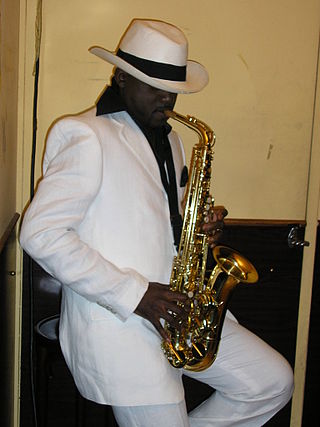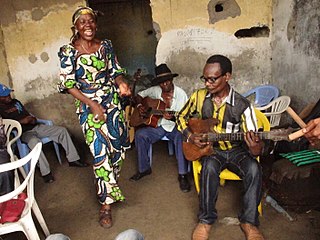Related Research Articles
Pop music is a type of popular music that originated in its modern form during the mid-1950s in the United States and the United Kingdom. During the 1950s and 1960s, pop music encompassed rock and roll and the youth-oriented styles it influenced. Rock and pop music remained roughly synonymous until the late 1960s, after which pop became associated with music that was more commercial, ephemeral, and accessible.
Given the vastness of the African continent, its music is diverse, with regions and nations having many distinct musical traditions. African music includes the genres amapiano, jùjú, fuji, afrobeat, highlife, Congolese rumba, soukous, ndombolo, makossa, kizomba,Taarab and others. African music also uses a large variety of instruments from all across the continent. The music and dance of the African diaspora, formed to varying degrees on African musical traditions, include American music like Dixieland jazz, blues, jazz, and many Caribbean genres, such as calypso and soca. Latin American music genres such as cumbia, salsa music, son cubano, rumba, conga, bomba, samba and zouk were founded on the music of enslaved Africans, and have in turn influenced African popular music.

The United States' multi-ethnic population is reflected through a diverse array of styles of music. It is a mixture of music influenced by the music of Europe, Indigenous peoples, West Africa, Latin America, Middle East, North Africa, amongst many other places. The country's most internationally renowned genres are traditional pop, jazz, blues, country, bluegrass, rock, rock and roll, R&B, pop, hip-hop/rap, soul, funk, religious, disco, house, techno, ragtime, doo-wop, folk, americana, boogaloo, tejano, reggaeton, surf, and salsa, amongst many others. American music is heard around the world. Since the beginning of the 20th century, some forms of American popular music have gained a near global audience.

The music of Kenya is very diverse, with multiple types of folk music based on the variety over 50 regional languages.

Art music is music considered to be of high phonoaesthetic value. It typically implies advanced structural and theoretical considerations or a written musical tradition. In this context, the terms "serious" or "cultivated" are frequently used to present a contrast with ordinary, everyday music. Many cultures have art music traditions; in the Western world, the term typically refers to Western classical music.

A burlesque is a literary, dramatic or musical work intended to cause laughter by caricaturing the manner or spirit of serious works, or by ludicrous treatment of their subjects. The word derives from the Italian burlesco, which, in turn, is derived from the Italian burla – a joke, ridicule or mockery.

Jean-Bosco Mwenda, also known as Mwenda wa Bayeke, was a pioneer of Congolese fingerstyle acoustic guitar music. He was also popular in other African countries, particularly in East Africa, and in the late 1950s and early 1960s was briefly based in Nairobi, Kenya, where he had a regular radio show and became a profound influence on a generation of Kenyan guitarists.

Soukous is a genre of dance music originating from the Democratic Republic of the Congo and the Republic of the Congo. It derived from Congolese rumba in the 1960s, with faster dance rhythms and bright, intricate guitar improvisation, and gained popularity in the 1980s in France. Although often used by journalists as a synonym for Congolese rumba, both the music and dance associated with soukous differ from more traditional rumba, especially in its higher tempo, song structures and longer dance sequences.

The Republic of the Congo is an African nation with close musical ties to its neighbor, the Democratic Republic of the Congo. The Democratic Republic of the Congo's homegrown pop music, soukous, is popular across the border, and musicians from both countries have fluidly travelled throughout the region playing similarly styled music, including Nino Malapet and Jean Serge Essous. Brazzaville had a major music scene until unrest in the late 1990s, and produced popular bands like Extra Musica and Bantous de la Capitale that played an integral role in the development of soukous and other styles of Congolese popular music. The Hip-Hop group "Bisso na Bisso" also hails from Congo-Brazzaville.

Taarab is a music genre popular in Tanzania and Kenya. It is influenced by the musical traditions of the African Great Lakes, North Africa, the Middle East, and the Indian subcontinent. Taarab rose to prominence in 1928 with the advent of the genre's first star, Siti binti Saad.

Benga is a genre of Kenyan popular music. It evolved between the late 1940s and late 1960s, in Kenya's capital city of Nairobi. In the 1940s, the African Broadcasting Service in Nairobi aired a steady stream of soukous, South African kwela, Congolese finger-style guitar and various kinds of Cuban dance music that heavily influenced emergence of benga. There were also popular folk songs of Tanzania and Kenya's Luo peoples that formed the base on benga creation.

The culture of Kenya consists of multiple traditions and trends. Kenya has no single prominent culture that identifies it. Its cultural heritage and modern expressions of culture instead consist of various cultures, shaped and practiced by the country's different communities.
Pop rock is a fusion genre characterized by a strong commercial appeal, with more emphasis on professional songwriting and recording craft, and less emphasis on attitude than standard rock music. Originating in the late 1950s as an alternative to normal rock and roll, early pop rock was influenced by the beat, arrangements, and original style of rock and roll. It may be viewed as a distinct genre field rather than music that overlaps with pop and rock. The detractors of pop rock often deride it as a slick, commercial product and less authentic than rock music.

Rockism and poptimism are ideological arguments about popular music prevalent in mainstream music journalism. Rockism is the belief that rock music depends on values such as authenticity and artfulness, which elevate it over other forms of popular music. So-called "rockists" may promote the artifices stereotyped in rock music or may regard the genre as the normative state of popular music. Poptimism is the belief that pop music is as worthy of professional critique and interest as rock music. Detractors of poptimism describe it as a counterpart of rockism that unfairly privileges the most famous or best-selling pop, hip hop and R&B acts.

Congolese rumba, also known as African rumba, is a dance music genre originating from the Republic of the Congo and Democratic Republic of the Congo. With its rhythms, melodies, and lyrics, Congolese rumba has gained global recognition and remains an integral part of African music heritage. In December 2021, it was added to the UNESCO list of intangible cultural heritage.

In many parts of sub-Saharan Africa, the use of music is not limited to entertainment: it serves a purpose to the local community and helps in the conduct of daily routines. Traditional African music supplies appropriate music and dance for work and for religious ceremonies of birth, naming, rites of passage, marriage and funerals. The beats and sounds of the drum are used in communication as well as in cultural expression.

Genge music is a genre of hip-hop music with influences from dancehall, originating from Nairobi, Kenya in the 1990s. The name was coined by the producer Clemo and popularized by Kenyan rappers Jua Cali and Nonini at Calif Records. It is commonly sung in Sheng, which is a mixture of words or phrases in Swahili, English and various local dialects. The term Genge is a Sheng word for "a group or a mass of people" [genge la watu].
Boomba music, also referred to as kapuka, is a form of hip pop music popular in Kenya. It incorporates hip hop, reggae and African traditional musical styles. The lyrics are in Swahili, Sheng or local dialects. It is associated with the Ogopa Deejays and is believed to have originated in the late 1990s with artists such as Redsan, Bebe Cool and Chameleone. It went on to dominate East African airwaves after the release of the Ogopa Deejays' first album in 2001, which included artists such as the late E-Sir, Nameless, Mr. Lenny, Amani, Mr. Googz and Vinnie Banton amongst others.
A music genre is a conventional category that identifies some pieces of music as belonging to a shared tradition or set of conventions. Genre is to be distinguished from musical form and musical style, although in practice these terms are sometimes used interchangeably.
Nashil Pichen Kazembe (1932–1991) was a Zambian singer from Kaputa District in the Luapula Valley, who gained prominence in the 1970s. He spent a large part of his life in Nairobi, Kenya, where he collaborated with fellow Zambia emigre Peter Tsotsi and Benson Simbeye. As members of Eagles Lupopo Band they sang 'patriotic songs' praising President Kenneth Kaunda and commenting on various social issues.
References
- ↑ Parkin, David J. (1991). Sacred void: spatial images of work and ritual among the Giriama of Kenya. Cambridge University Press. p. 121. ISBN 978-0-521-40466-2.
- ↑ Senoga-Zake, George W. (2000). Folk music of Kenya. Uzima Publishing House. pp. 62–65. ISBN 978-9966-855-02-2.